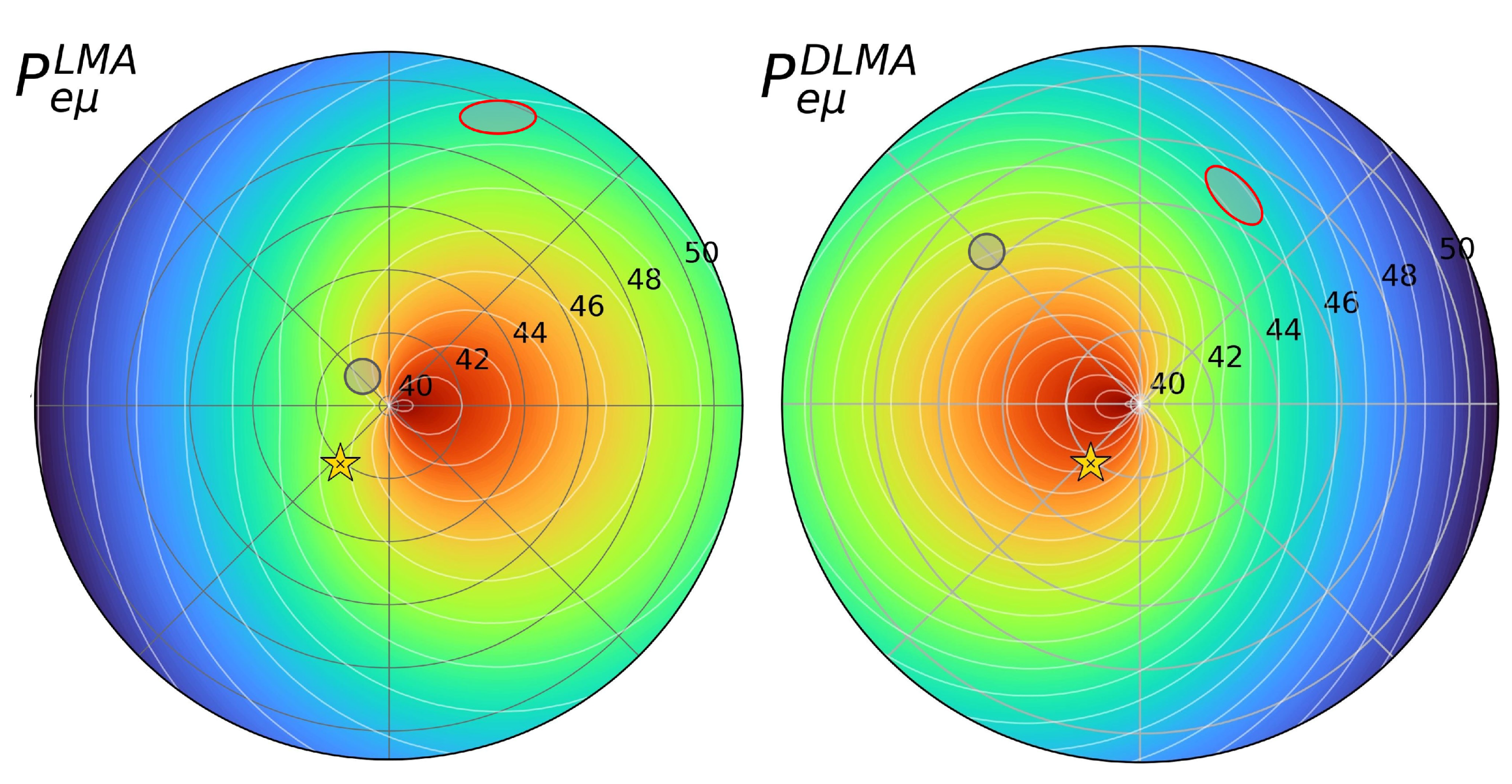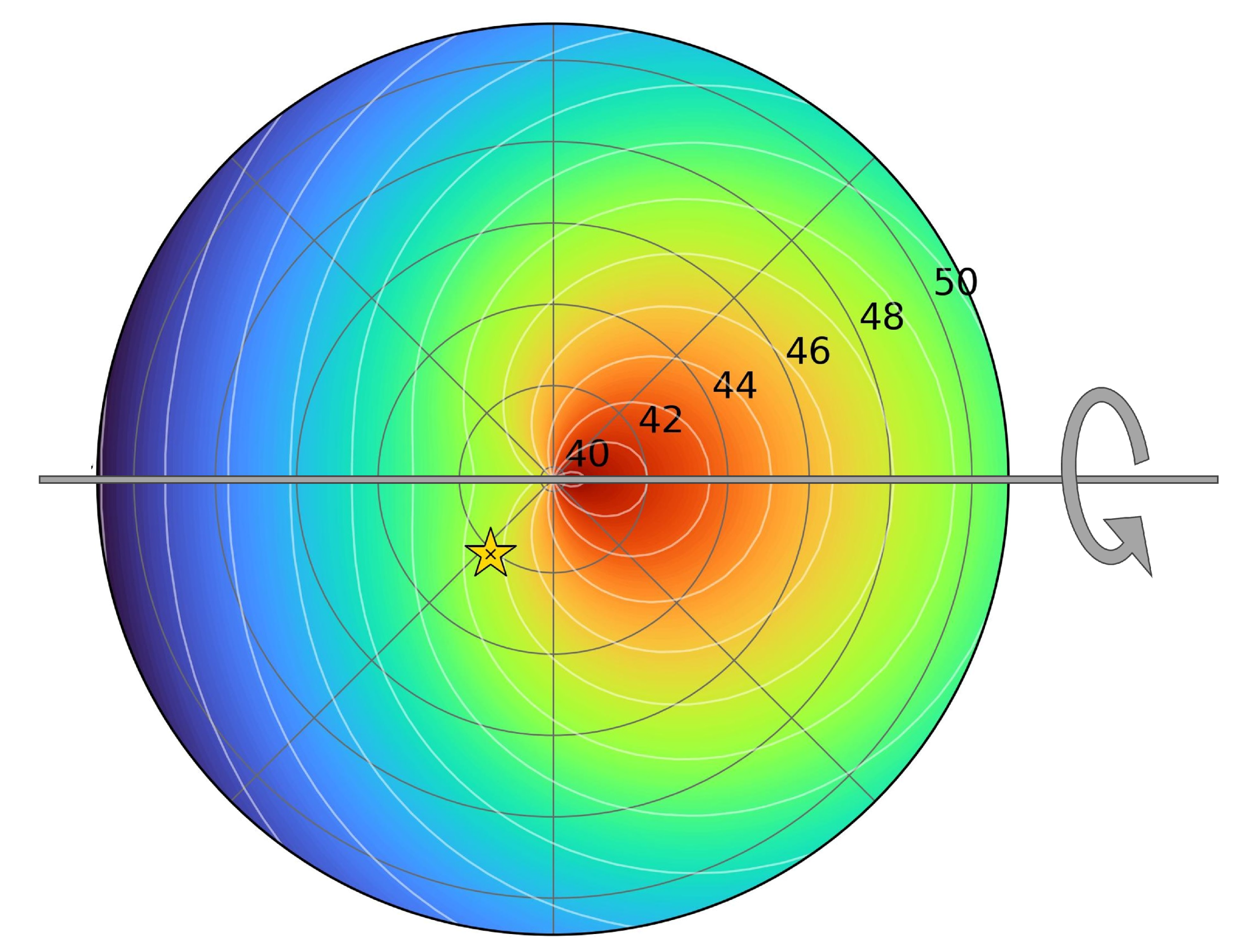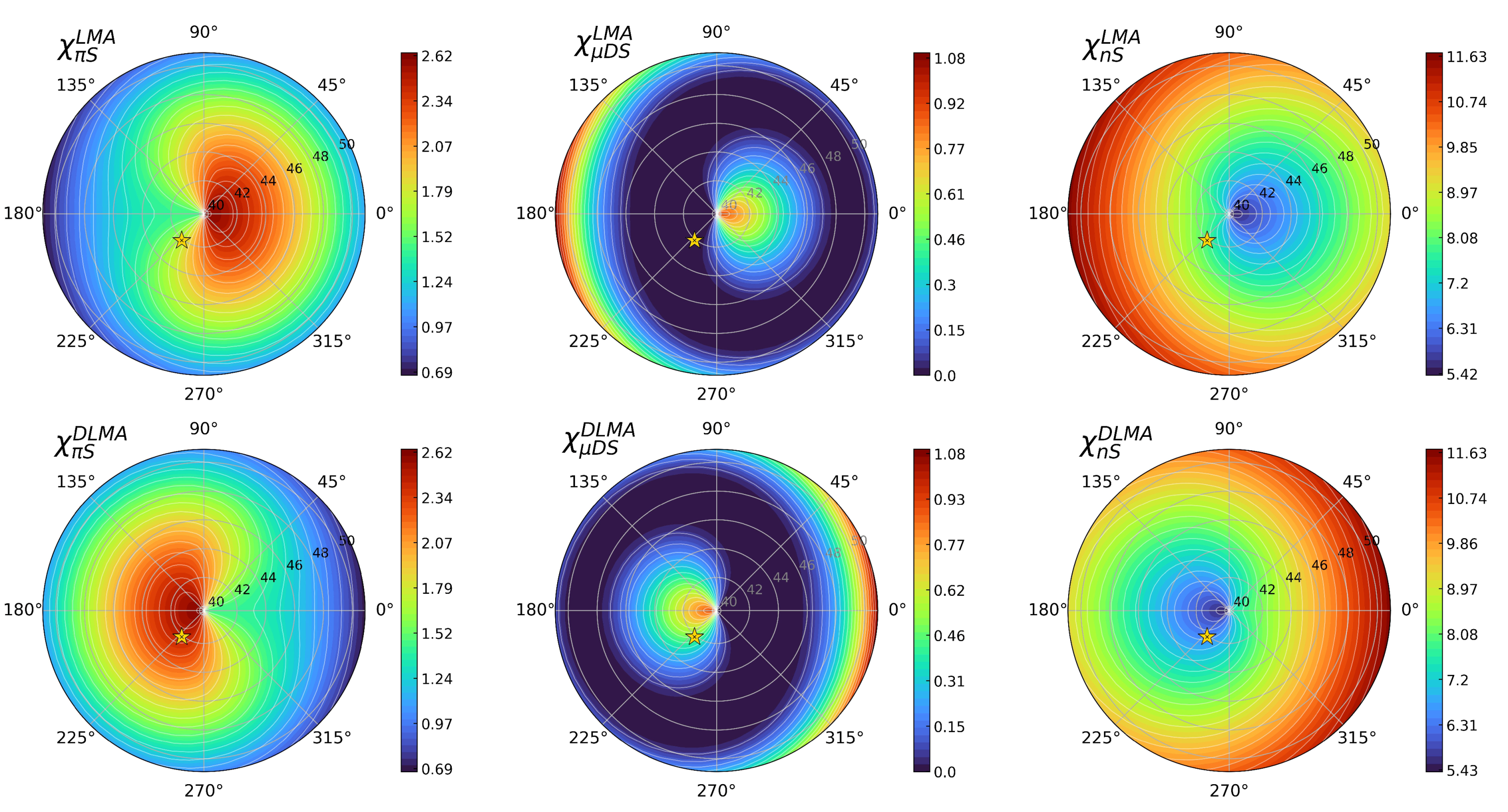Implications of the DLMA Solution of θ12 for IceCube Data Using Different Astrophysical Sources
Abstract
1. Introduction
2. Oscillation of the Astrophysical Neutrinos
- For a given value of , we notice a parameter degeneracy defined by . This can be observed from the panels in the left and the middle column in the following way. Imagine rotating the panels corresponding to the DLMA solution around the axis (perpendicular to the plane of the paper) passing through the center by . These panels now look the same as the ones for the LMA solution (shown explicitly in the Appendix A). This transformation represents degeneracy between the two solutions. This can also be seen by drawing an imaginary vertical line on panels in the right column. For example, this is shown by the vertical line at .From the right column of Figure 1, one can see that the probability for point A is the same as the probability in point and similar for B as . And the points A and (also B and ) are separated by . We also see that points A() (blue plus) and B() (red plus) are degenerate with each other. We discuss this later. The origin of degeneracy discussed above, also known as Coloma–Schwetz symmetry, stems at the Hamiltonian level. In vacuum oscillations, the Hamiltonian of neutrino oscillation is invariant for the following transformation [9]:This can also be viewed from Equation (5) to Equation (8) in the following way. The difference between the probabilities due to the the LMA and DLMA solutions while keeping other parameters constant can be calculated as . Then, the differences are given as follows:It can be observed that when and . We identify that the terms and are the reason behind the degeneracies of LMA and DLMA solutions with and . If we equate the probabilities for LMA and DLMA at fixed , then the relation between different values for LMA and DLMA is given asTherefore, from the IceCube experiment alone, it will not be possible to separate the LMA solution from the DLMA solution. However, if can be measured from a different experiment, then IceCube gives the opportunity to break the generalized mass-ordering degeneracy as the oscillation probabilities are independent of in IceCube.
- In these probabilities, there also exists a degeneracy between and the two solutions of for a given value of . This can be viewed from the right column by drawing an imaginary horizontal line in the right panels. To show this, we drew a horizontal line at . This line intersects blue curves and orange curves having equal probabilities, showing the degeneracy between and the two solutions of for a given value of . This degeneracy can also be seen on polar plots. Here, fixing the value of is equivalent to drawing a line that comes out of the center at a polar angle that is equal to the value of . Next, we pick a certain shade of color, which corresponds to fixing a value of the probability. By reading the value of the radius where the line and this colored patch intersect, we obtain , which does not necessarily have to be the same for the LMA and DLMA solutions (shown explicitly in the Appendix A). However, unlike the degeneracy mentioned in the earlier item, this degeneracy is not intrinsic.The degenerate values of corresponding to the LMA and DLMA solutions for a particular probability depend on the value of . Let us show this explicitly in the case of . This degeneracy for is defined by which gives,This implieswhere and are constants.The solution suggests that the degenerate solution is given by . But this cannot be observed in Figure 1, as do not lie in the range of . For the other solution, with and , it gives simply , i.e., , as seen Figure 1. In the case of other values of , the angles and are connected by a quadratic equation, i.e., two degenerate solutions. For , and are degenerate solutions, which is consistent with the points E and E, respectively, in the top-right panel of Figure 1 corresponding to the value of 0.23.
- One more degeneracy defined by is easily visible in left and middle columns. It can be seen from the probability expressions that are degenerate for . This degeneracy within each of the LMA and DLMA solutions can be seen if the plots are flipped around a horizontal line going through the center. Each plot looks the same if it is flipped around that line (shown explicitly in the Appendix A). As mentioned earlier, this degeneracy is the reason why points A () and B () in the right column are degenerate. This degeneracy arises from
3. Analysis and Results
- Among the three sources, the source is the most preferred source by the IceCube data as, for this source, we obtain a minimum value of 0 for both the LMA and DLMA solutions (middle column of Figure 2). From the panels, we see that the data do not prefer a particular value of and , rather they are consistent with a region in the – plane. The best-fit regions of the – plane can be understood by looking at the middle column of Figure 3. In these panels, the value of is drawn over R. This shows the values of – for which the prediction of the track by shower ratio matches exactly with the data. Note that though in the middle column of Figure 3 is a curve, the best-fit region in the middle column of Figure 2 is not a curve; rather, it is a plane. The reason is two fold: (i) In Figure 2, we marginalized over the parameters and . Because of this, there can be much more combinations of and , which can give the exact value of as compared with Figure 3, which is generated for a fixed value of and . (ii) In polar plots, we do not have the precision to shade a region corresponding to exactly . In these plots, is defined by a large set of very small numbers. This is why the best-fit region appears as a large black area. As we mentioned earlier, with the help of the plots, we can infer the true nature of given is measured from the other experiments. According to the current-best fit scenario, it can be said that IceCube data prefer the LMA solution of because, at this best-fit value (denoted by the star), we obtain the nonzero for the DLMA solution of .
- The second most favored source according to the IceCube data is the source. For this source, the minimum is 0.7. As the minimum value is much less, one can say that the source and the source are almost equally favored. In this case, the best-fit region in the – plane is smaller than the source. For this source, the upper octant of is preferred for both the LMA and DLMA solutions of . Regarding , the best-fit value is around for the LMA solution of , whereas for the DLMA solution of , the best-fit value is around . For this source, the current best-fit value (denoted by a star) is excluded at for the LMA (DLMA) solution of .
- The n source is excluded by IceCube at more than C.L., as the minimum in this case is 5.4. Similar to the source, in this case, the best-fit region in the – plane is smaller than the source. This source prefers the lower octant of for both the LMA and DLMA solutions of . Regarding , the best-fit value is around for the DLMA solution of , whereas for the LMA solution of , the best-fit value is around . For this source, the current best-fit value (denoted by a star) is excluded at for the LMA (DLMA) solution of .
4. Summary and Conclusions
Author Contributions
Funding
Data Availability Statement
Acknowledgments
Conflicts of Interest
Appendix A



| 1 | Note that apart from AGNs and GRBs, IceCube is capable of detecting neutrinos from any other sources as far as the energy of the neutrinos is more than TeV and flux of the neutrinos are high. For example, recently, IceCube has detected neutrinos from the galactic plane at C.L [18]. |
References
- Esteban, I.; González-García, M.C.; Maltoni, M.; Schwetz, T.; Zhou, A. The fate of hints: Updated global analysis of three-flavor neutrino oscillations. JHEP 2020, 9, 178. [Google Scholar] [CrossRef]
- Abe, K. et al. [T2K Collaboration] Measurements of neutrino oscillation parameters from the T2K experiment using 3.6×1021 protons on target. arXiv 2023, arXiv:2303.03222. [Google Scholar]
- Acero, M.A. et al. [NOvA Collaboration] Improved measurement of neutrino oscillation parameters by the NOvA experiment. Phys. Rev. D 2022, 106, 032004. [Google Scholar] [CrossRef]
- De Gouvea, A.; Friedland, A.; Murayama, H. The Dark side of the solar neutrino parameter space. Phys. Lett. B 2000, 490, 125–130. [Google Scholar] [CrossRef]
- Choubey, S.; Bandyopadhyay, A.; Goswami, S.; Roy, D.P. SNO and the solar neutrino problem. In Proceedings of the Conference on Physics Beyond the Standard Model: Beyond the Desert 02, Oulu, Finland, 2–7 June 2002; Volume 9, pp. 291–305. [Google Scholar]
- Miranda, O.G.; Tórtola, M.A.; Valle, J.W. Are solar neutrino oscillations robust? JHEP 2006, 10, 8. [Google Scholar] [CrossRef]
- Gonzalez-Garcia, M.C.; Maltoni, M. Determination of matter potential from global analysis of neutrino oscillation data. JHEP 2013, 9, 152. [Google Scholar] [CrossRef]
- Dev, B.; Babu, K.S.; Denton, P.; Machado, P.; Argüelles, C.A.; Barrow, J.L.; Chatterjee, S.S.; Chen, M.C.; de Gouvêa, A.; Dutta, B.; et al. Neutrino Non-Standard Interactions: A Status Report. SciPost Phys. Proc 2019, 2, 001. [Google Scholar] [CrossRef]
- Coloma, P.; Schwetz, T. Generalized mass ordering degeneracy in neutrino oscillation experiments. Phys. Rev. D 2016, 94, 055005. [Google Scholar] [CrossRef]
- Choubey, S.; Pramanik, D. On Resolving the Dark LMA Solution at Neutrino Oscillation Experiments. JHEP 2020, 12, 133. [Google Scholar] [CrossRef]
- Vishnudath, K.N.; Choubey, S.; Goswami, S. New sensitivity goal for neutrinoless double beta decay experiments. Phys. Rev. D 2019, 99, 095038. [Google Scholar]
- Coloma, P.; Gonzalez-Garcia, M.C.; Maltoni, M.; Schwetz, T. COHERENT Enlightenment of the Neutrino Dark Side. Phys. Rev. D 2017, 96, 115007. [Google Scholar] [CrossRef]
- Denton, P.B.; Farzan, Y.; Shoemaker, I.M. Testing large non-standard neutrino interactions with arbitrary mediator mass after COHERENT data. JHEP 2018, 7, 37. [Google Scholar] [CrossRef]
- Coloma, P.; Denton, P.B.; Gonzalez-Garcia, M.C.; Maltoni, M.; Schwetz, T. Curtailing the Dark Side in Non-Standard Neutrino Interactions. JHEP 2017, 4, 116. [Google Scholar] [CrossRef]
- Esteban, I.; Gonzalez-Garcia, M.C.; Maltoni, M.; Martinez-Soler, I.; Salvado, J. Updated constraints on non-standard interactions from global analysis of oscillation data. JHEP 2018, 8, 180. [Google Scholar] [CrossRef]
- Coloma, P.; Gonzalez-Garcia, M.C.; Maltoni, M.; Pinheiro, J.P.; Urrea, S. Global constraints on non-standard neutrino interactions with quarks and electrons. arXiv 2023, arXiv:2305.07698. [Google Scholar] [CrossRef]
- Aartsen, M.G. et al. [IceCube Collaboration] Evidence for High-Energy Extraterrestrial Neutrinos at the IceCube Detector. Science 2013, 342, 1242856. [Google Scholar]
- Abbasi, R. et al. [IceCube Collaboration] Observation of high-energy neutrinos from the Galactic plane. Science 2013, 380, 6652. [Google Scholar]
- Waxman, E.; Bahcall, J.N. High-energy neutrinos from astrophysical sources: An Upper bound. Phys. Rev. D 1999, 59, 023002. [Google Scholar] [CrossRef]
- Hümmer, S.; Baerwald, P.; Winter, W. Neutrino Emission from Gamma-Ray Burst Fireballs, Revised. Phys. Rev. Lett. 2012, 108, 231101. [Google Scholar] [CrossRef] [PubMed]
- Moharana, R.; Gupta, N. Tracing Cosmic accelerators with Decaying Neutrons. Phys. Rev. D 2010, 82, 023003. [Google Scholar] [CrossRef]
- Athar, H.; Jeżabek, M.; Yasuda, O. Effects of neutrino mixing on high-energy cosmic neutrino flux. Phys. Rev. D 2000, 62, 103007. [Google Scholar] [CrossRef]
- Rodejohann, W. Neutrino Mixing and Neutrino Telescopes. JCAP 2007, 1, 29. [Google Scholar] [CrossRef][Green Version]
- Meloni, D.; Ohlsson, T. Leptonic CP violation and mixing patterns at neutrino telescopes. Phys. Rev. D 2012, 86, 067701. [Google Scholar] [CrossRef]
- Mena, O.; Palomares-Ruiz, S.; Vincent, A.C. Flavor Composition of the High-Energy Neutrino Events in IceCube. Phys. Rev. Lett. 2014, 113, 091103. [Google Scholar] [CrossRef]
- Chatterjee, A.; Devi, M.M.; Ghosh, M.; Moharana, R.; Raut, S.K. Probing CP violation with the first three years of ultrahigh energy neutrinos from IceCube. Phys. Rev. D 2014, 90, 073003. [Google Scholar] [CrossRef]
- Denton, P.B.; Parke, S.J. Simple and Precise Factorization of the Jarlskog Invariant for Neutrino Oscillations in Matter. Phys. Rev. D 2019, 100, 053004. [Google Scholar] [CrossRef]
- Abbasi, R. et al. [IceCube Collaboration] The IceCube high-energy starting event sample: Description and flux characterization with 7.5 years of data. Phys. Rev. D 2021, 104, 022002. [Google Scholar] [CrossRef]
- Lyons, L. Statistics for Nuclear and Particle Physicists; Cambridge University Press: Cambridge, UK, 1989. [Google Scholar]



| Parameter | Best Fit | Marginalization Range |
|---|---|---|
| (LMA) | : | |
| (DLMA) | : | |
| : | ||
| : | ||
| : |
| Category | TeV | TeV | Total |
|---|---|---|---|
| Total Events | 42 | 60 | 102 |
| Cascade | 30 | 41 | 71 |
| Track | 10 | 17 | 27 |
| Double Cascade | 2 | 2 | 4 |
| Morphology | Cascade | Track | Double Cascade |
|---|---|---|---|
| Total | 72.7% | 23.4% | 3.9% |
Disclaimer/Publisher’s Note: The statements, opinions and data contained in all publications are solely those of the individual author(s) and contributor(s) and not of MDPI and/or the editor(s). MDPI and/or the editor(s) disclaim responsibility for any injury to people or property resulting from any ideas, methods, instructions or products referred to in the content. |
© 2023 by the authors. Licensee MDPI, Basel, Switzerland. This article is an open access article distributed under the terms and conditions of the Creative Commons Attribution (CC BY) license (https://creativecommons.org/licenses/by/4.0/).
Share and Cite
Ghosh, M.; Goswami, S.; Pan, S.; Pavlović, B. Implications of the DLMA Solution of θ12 for IceCube Data Using Different Astrophysical Sources. Universe 2023, 9, 380. https://doi.org/10.3390/universe9090380
Ghosh M, Goswami S, Pan S, Pavlović B. Implications of the DLMA Solution of θ12 for IceCube Data Using Different Astrophysical Sources. Universe. 2023; 9(9):380. https://doi.org/10.3390/universe9090380
Chicago/Turabian StyleGhosh, Monojit, Srubabati Goswami, Supriya Pan, and Bartol Pavlović. 2023. "Implications of the DLMA Solution of θ12 for IceCube Data Using Different Astrophysical Sources" Universe 9, no. 9: 380. https://doi.org/10.3390/universe9090380
APA StyleGhosh, M., Goswami, S., Pan, S., & Pavlović, B. (2023). Implications of the DLMA Solution of θ12 for IceCube Data Using Different Astrophysical Sources. Universe, 9(9), 380. https://doi.org/10.3390/universe9090380







